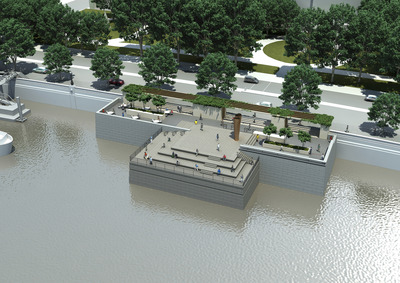Thames Tideway Tunnel project standardises on Bentley’s ProjectWise
Bentley Systems, a provider of software solutions for sustaining infrastructure, has announced standardisation on the company’s ProjectWise to provide collaboration, work sharing and engineering content management for Thames Water’s Thames Tideway Tunnel project. The project is addressing the issue of combined sewage discharges from London’s Victorian-era sewer system that enter the River Thames, to enhance water quality and help sustain the river for future generations.

The program manager for the $6.1 billion project, CH2M Hill, is confident that the ProjectWise system of collaboration servers and services will increase the project team’s productivity and decrease project delivery costs by providing information mobility across disciplines and project phases with data integrity. Additional Bentley software used includes Structural Modeler, AECOsim Building Designer, STAAD, InRoads, gINT, Bentley Navigator and ProjectWise InterPlot.
There are more than 20 principal partners involved in the project and 50 other companies engaged in the pre-planning phase. The project team needed a scalable solution to facilitate collaboration with multiple subcontractors and allow them to accurately predict costs for the fixed-price project. ProjectWise enables the team to efficiently manage design processes, project data, governance, standards and subcontractors within a single federated and secure data environment. The Bentley information modelling, structural and civil applications enable interoperability, supporting collaborative and streamlined multidisciplinary workflows.
Simon Williams-Gunn, engineering systems lead, Thames Tideway Tunnel project, said, “Thames Water will use ProjectWise to deliver models and drawings for planning processes based on BS 1192, enabling us to collaboratively work together within single and multiple offices and teams using the same information at once. We are going to be expanding into a huge team to deliver the project and we wanted to put into place tools that enabled us to both accommodate the requirements at an early stage of the project and also scale into the full delivery of the project as it grows.”
The Thames Tideway Tunnel team is using the ProjectWise Business Process Template that incorporates the BS 1192 processes and naming standards, with appropriate folder structures and workflow conventions. ProjectWise also provides automated support of numerous key activities including searching, creating, registering, checking and issuing documents, as well as the tools for managing CAD standards to ensure that the growing team can create consistent work.
With ProjectWise, the project team could accurately cost the project and minimise the risk of needing additional resources for information management as the project grows. Williams-Gunn said, “We needed to predict what the costs would be due to it being a fixed-cost project. If we had put in the resources required to manually manage this much information, the cost would have probably been 10 times that of our new system.”
The London sewer system uses a single pipe to carry both sewage and stormwater run-off. It was designed to overflow into the tidal River Thames via combined sewer overflows (CSOs) during extreme rainfall, when the sewers reach capacity, to prevent homes and streets from flooding. But modern-day pressures, including population growth and increased precipitation, have resulted in increased discharges into the tidal River Thames.
To capture this overflow early, there will be shafts 6 m across and 60 m deep at 22 CSO sites along the path of the tunnel that drop the flow down to the main tunnel. Williams-Gunn explained, “we’re building a building underground, if you like, using Structural Modeler to create 3D models.” In addition, Structural Modeler and AECOsim Building Designer are being used to create 3D models of other elements and structures at the CSO sites, including the shafts, head houses, stacks, and other buildings and landscaping.
The 3D models are shared with other software tools for fluid dynamic calculations as well as GIS software for studying the environmental impact of the stacks and the resulting odour. STAAD is used for structural analysis of reinforcement issues, such as where CSOs enter the river near bridges. The 3D models are also used to produce the 2D drawings necessary for engineering, planning and environmental needs.
The tunnel will be London’s deepest ever - 75 m down at its lowest point - and the project team must avoid other tunnels and conduits used for rail, road, electricity, gas and communications infrastructure. Moreover, it must prevent ground settlement from damaging the surrounding buildings. Settlement analysis will be conducted wherever the tunnel passes beneath or close to buildings and other structures, and mitigation efforts will be implemented as required.
The team is using InRoads to manage horizontal, vertical and 3D alignments of both the main tunnel and various connection tunnels. It is implementing gINT to manage the geotechnical data needed for the tunnel, as its prior software was unable to handle the necessary quantity of data.
The Thames Tideway Tunnel project team will employ easy-to-use web tools to provide the required information to project decision-makers. Bentley Navigator will supply web-based access to 3D models for design review and clash detection. In addition, ProjectWise InterPlot will be used for publishing both web-based document sets and paper construction documents. The goal is to make all project information available to the team online.
Beef processor selects wastewater pump solution for dual purpose
John Dee Warwick wanted to upgrade its wastewater pump system to handle the day-to-day flows...
Melbourne Water finds an energy-saving solution
Sewage and wastewater treatment is a highly energy-intensive process, presenting a challenge for...
Gorman-Rupp pumps "don’t miss a beat" for Kingston SE Council
The pumps used for the wastewater pumping operations in the Kingston District Council don't...









